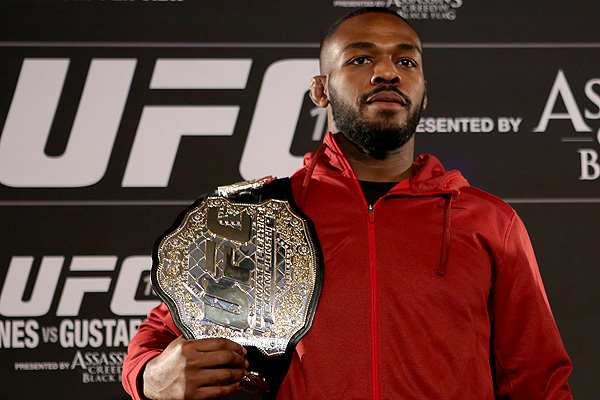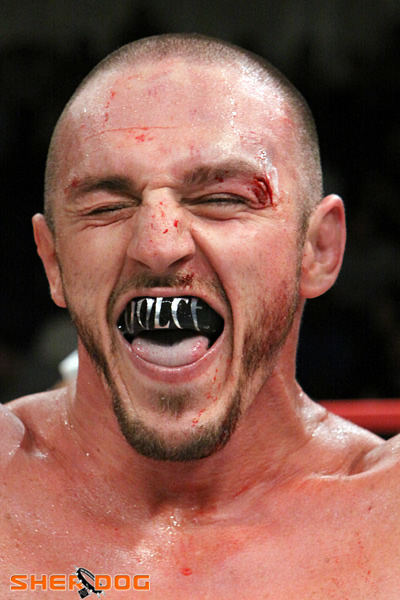Universal Soldiers
Growing Sophistication

Jon
Jones embodies the well-rounded mixed martial artist. | Photo: D.
Mandel/Sherdog.com
In the late 1990s, Miletich brought together an elite stable of fighters under one roof in Bettendorf, Iowa, to spar with and work off of each other, solidifying the model for the modern fight camp. Miletich Fighting Systems reigned atop the sport in the early 2000s, boasting champions like Jens Pulver, Matt Hughes, and Tim Sylvia. Miletich -- who boxed, kickboxed and wrestled prior to embarking on a life in MMA -- has a measuring stick to determine a fighter’s readiness. Is he good enough at each fighting discipline that he could hang with pros? In other words, is he good enough at boxing to spar 12 rounds in a pro gym, good enough at wrestling to hold his own in a collegiate wrestling room, good enough at jiu-jitsu to not get embarrassed by black belts?
At the time, sharpening each of these skills required some significant commuting. It was not long ago that the top fighters in MMA had to schlep around entire metropolitan areas to train different disciplines in different gyms. Fighters today are more likely to train every discipline under the same roof, as gyms have the funds to hire specialists to exclusively train them. After all, MMA is now basically its own independent martial arts style, rather than an ultimate compendium of them all. Miletich thinks this approach is lacking because it can deprive fighters of the chance to glean deeper insights into the individual skills that make up the game.
Advertisement
Javier Mendez has thrived without trying to become a jack of all trades. A former world champion kickboxer, Mendez founded the American Kickboxing Academy in the late 1990s in a former glass shop in San Jose, Calif. He has churned out some of the world’s best MMA fighters -- Cain Velasquez, Josh Thomson and Jon Fitch among them -- but still regards his facility as a kickboxing gym. Only recently did he add staff for other disciplines, like former Olympic wrestler Daniel Cormier and decorated jiu-jitsu black belt Leandro Vieira.
“I let the experts do what the experts do,” Mendez said. “There is
only so much you can really learn. You want to have the best
available.”

Photo:
Joe Harrington/Sherdog.com
Dolce specializes in nutrition.
It all could not be more different from the first fight camp Mendez oversaw, that of old school MMA fighter Brian Johnston in 1996. For that camp, if you could call it that, Mendez brought in a friend who had a black belt in judo to try to throw around Johnston; and he put Johnston through kickboxing mitt work. There were not many sparring partners around who could account for the three-dimensional nature of an MMA fight, and sparring just traditional boxing or kickboxing could instill counterproductive habits.
“We basically didn’t know what the hell we were doing,” Mendez said. “We just did what we knew.”
At the time, many fighters looked at the Ultimate Fighting Championship as a way to monetize skills and qualities they already possessed: toughness, athleticism and experience in other fight sports. However, as the years passed, Mendez noticed a fundamental change in how his trainees viewed what they were doing. Fighting for them was also something of a spiritual quest, a life’s calling, a way of living.
“A lot of the MMA fighters call themselves ‘martial artists.’ Back in the older days, kickboxers and boxers would call themselves ‘fighters,’” Mendez said. “The word ‘fighter’ to most of these guys means you’re nothing but a brute.”
Under the tutelage of strategists like Jackson, fighters are tailoring their approaches to bouts based not on imposing their strengths but selectively calling on them based on what a particular opponent brings. When it comes to executing in the cage for today’s top fighters, it is less about how and more about when.
“There’s no absolutes in fighting,” Jackson said. “There are only what works in the parameters you are given.”
The prime example, Jackson said, is reigning UFC light heavyweight champion Jon Jones, who may be on track to becoming the greatest fighter in MMA history. The incredibly lanky former junior college wrestler does not do one thing in a blow-away fashion; he just knows how to get to them in a way that is instinctual, almost preternatural. He stunned his coaches with his ability to copy moves he saw performed on YouTube videos and incorporate effective technique into his unique in-cage rhythm.
“He doesn’t have a lot of formal training,” Jackson said. “I think Jon is just a product of the system of what MMA is, and that’s being well-rounded everywhere. He’s just the new model.”
All of this to say, there are only so many factors for which you can account and control prior to the cage door closing. One thing you can control is how you feel entering the cage, and that hinges on how your weight cut went. Modern fighters dread making weight, the true mental and physical hurdle they face in a training camp. By the time they have sucked down their body fat and rehydrated after stepping off the scale, the fight can feel like some kind of strange, perilous reward.
Initially, there were no weight classes in the UFC, and for years there were only two or three. Most fighters competed nearest their natural weight and ate whatever they thought would help them. Today, with eight UFC weight classes, deep consideration goes into each ounce of food consumed. Former fighter Mike Dolce specializes in this process, and several of the top names in MMA subscribe to his “Dolce Diet” regimen, which he says proudly is the result of overthinking every aspect of nutrition and dieting and their effect on performance.
“We’re competing within the top three percent of all human beings,” Dolce said. “There’s no margin for error.”
Dolce breaks down the requirements of his athletes to the micronutrient, and even factors in circadian rhythms and a fighter’s cultural ethnicity into his dieting plans. He obsesses over how much protein a fighter takes in per 0.8 pounds of lean body mass, a metric he said can spell the difference between a tortuous and a seamless weight cut.
“Calories are so boring to me now,” Dolce said. “They’re such a small part of it.”
Of course, as the scientific sophistication and earning potential of fighters has grown, so has buzz that fighters are doping and masking to get an edge. MMA has had more than its share of high-profile steroid test failures since screens were implemented in the 2000s, and it seems to be the only sport that accepts athletes injecting synthetic testosterone if they can produce a note and a hazy diagnosis from a doctor explaining why their natural testosterone is low.
Those who have copped to using steroids and other banned substances have consistently cited the need to quickly mend injuries, perhaps the most pressing concern and vexing risk facing the modern fighter. Injuries, particularly ligament strains and tears, have become rampant in recent years at the top level of the sport, have spoiled a litany of highly anticipated fights and altered the course of a fighter’s career in an instant.
“
because I was a Shamrock, but what
we missed in collaboration was huge.
”
Perhaps the motley crews that fought in the inaugural UFCs did not redefine martial arts. Rather, they showed us that the definition of martial arts is living, breathing and evolving only to the extent that its exponents are willing to put it to the test.
Related Articles







